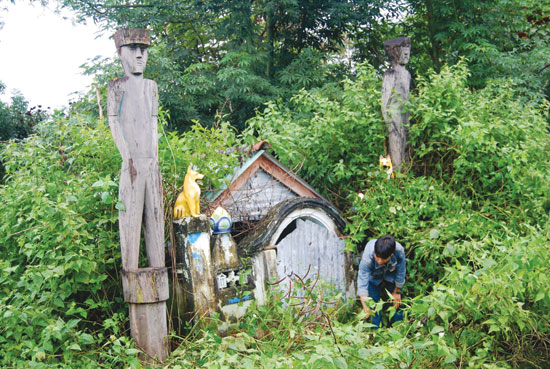No 3, Vol.10 , September – October 2015

A grave of Gia-rai people after the abandonment ceremony with wooden
statues and glazed dogs. Photo: Huynh Van My
The graveyards of the Gia-rai people are not necessarily located in some dense, century-old forest far from their village. They can be a clearing near the village, preferably with a few old trees and saplings.
Like some other ethnic tribes in Tay Nguyen, Central Highlands, (such as Ba-na, Ro-mam, Ro-ngao, and Ho-lang) the most prominent feature of Gia-rai graveyards are the grave statues which are placed into the tomb after the abandonment ceremony. After that, the relatives abandon the grave completely, returning it to the land and the forest.
A group of wooden statues at a grave in Kep 2 Village, La Mo Nong Commune, Chu Pah Dist., Gia Lai Province. Photos: Ngo Huy Tinh
The grave statue is a loving sacrifice, the last gift of the loved ones to the dead to show their feelings. Made with rudimentary tools of strong and valuable woods, such as kingwood, narra-padauk and meranti, they are durable under sun and rains, show the highlanders’ carving abilities, as well as their distinct culture and aesthetics. They also reflect the wealth of the family; rich families make big statues from rare woods and poor ones only make small statues of ordinary wood, quickly carved and painted.
A group of wooden statues at a grave in Kep 2 Village, La Mo Nong Commune, Chu Pah Dist., Gia Lai Province. Photos: Ngo Huy Tinh
Like the food served during the abandonment ceremony, these statues cost the bereaved family dearly. Many can’t afford a ceremony. Many have to pay so much for the ceremony that they have no money left for their children’s wedding. They have to let the betrothed live together for a few years before they can treat the people of the village to a wedding.
A group of wooden statues at a grave in Kep 2 Village, La Mo Nong Commune, Chu Pah Dist., Gia Lai Province. Photos: Ngo Huy Tinh
Gia-rai grave statues, as a cultural feature, are on the decline due to deforestation. Almost no quality wood for making statues is left in the area. Theft of grave statues for sale as ethnic cultural items is so widespread that it deters the living from honouring their dead in the traditional way. Wooden statues have been replaced by plaster ones. People visit and take care of the graves more frequently without abandoning them.
A group of wooden statues at a grave in Kep 2 Village, La Mo Nong Commune, Chu Pah Dist., Gia Lai Province. Photos: Ngo Huy Tinh
The new picture of the Gia-rai people’s graveyards reflects the inevitable cultural exchange between the highland and lowland in the development process. But it is also a sign of cultural decline. And perhaps, grave statues will soon be reduced to a tale of once upon a time on the Tay Nguyen highlands.n

